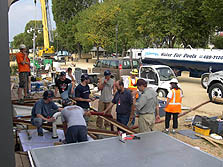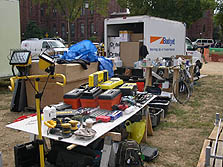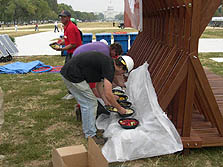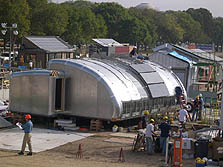

Although we can generate electricity from the sun, we can't generate water from the sun. So, we had that trucked in. Here, Virginia Tech receives its water supply.

Like any construction site that is nearing deadline, the RISD team has their tools and equipment at the ready. With an eye on safety, the team remains well organized amidst the chaos.

Dinner time! The Rhode Island team digging in for some much deserved food.

Yesterday, I said I was anxious to see the endcaps on the Michigan Solar Decathlon house. Well, here they. With all the houses fully enclosed, I am sure they will all be ready to show by Thursday.
Solar Decathlon 2005
Daily Journal — October 4, 2005
This is it. The last day to complete major construction. Yet another milestone on this long, but tremendously rewarding adventure. Although the Solar Decathlon opens in two days, teams need to have their houses ready for safety and code inspections by 10 a.m. tomorrow. So, that means there is only one full day of work left. And, I'm sure a sleepless night for more than a few students.
I just talked to the instrumentation crew and with major construction nearly done, they were able to install data loggers in 14 of the 18 houses. We are definitely making progress. The data loggers will be used to monitor the performance of the houses and are the key component used to score contests 5-10 (comfort zone, appliances, hot water, lighting, energy balance, and getting around).
Other contests are heavily dependent on the availability of water because the Solar Decathlon simulates activities that happen in a typical home. Solar Decathletes will have to wash dishes and towels throughout the week, in addition to running showers. However, just as there is no electricity on the Mall (other than what the PV systems on the Decathlon homes generate), there is no water utility. So, tanker trucks today delivered the 500 gallons of water the teams will need over 10-day competition. The water is used to fill hot water tanks and storage tanks for domestic use.
Water isn't the only scarce resource on the National Mall. Tools and building supplies are also hard to come by. There are no DIY superstores next to the Washington Monument, so teams brought everything they needed to the site. That includes tools and building materials. Right now, each lot is cluttered with table saws, workbenches, drills, containers, pallets, siding, lumber, paint cans, and pails. Some teams have stuff piled so high you can't see their front door. Of course, all this will be removed in time for the safety inspections tomorrow morning, and we can get a better sense of what the solar village will look like.
Our village has most of the amenities of any other village — except perhaps a supermarket. The only restaurants nearby are in the Smithsonian museums — so food is a bit hard to come by. The team "moms" work hard to keep the teams fed, bringing in meals and setting the "dining room table" on anything that will suffice. As soon as the food is ready, some very hungry workers chow down.
And the teams? I am happy to say Michigan has a fully enclosed house! They worked late last night to install both end sections. And the Rhode Island School of Design has their house enclosed too! After some final adjustments, the center section of their house was completely installed as of this morning. Now I feel confident all the teams will be ready to show by Thursday.
Tomorrow in the afternoon teams have a dress rehearsal for the opening ceremony. The culmination of all the hard work is soon at hand. I can't wait!
Reporting from the village
Richard King, Department of Energy
